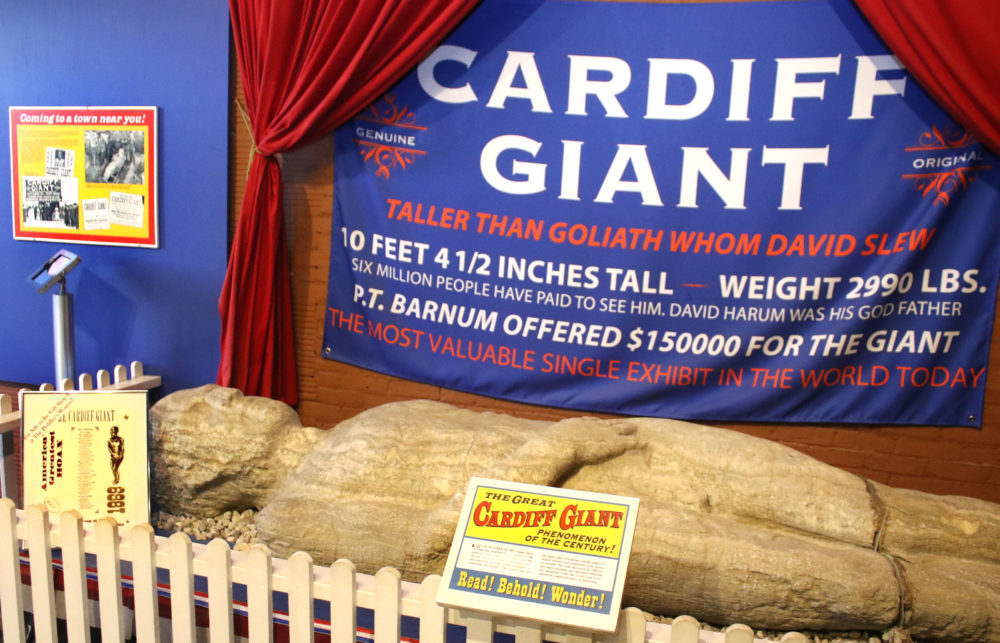Age 150, Cardiff Giant
Still Excites Enthusiasm

By LIBBY CUDMORE • Special to www.AllOTSEGO.com
COOPERSTOWN – It’s 150 years later, and New York State’s greatest hoax is still bringing in the gawkers.
“The Cardiff Giant is still a favorite,” said Todd Kenyon, The Farmers’ Museum communications director. “It’s part of American folklore.”
On Wednesday, Oct. 16, got into The Farmers’ for just 50 cents, the original price paid to see it under a tent in George Hull’s backyard. That evening, visitors were able to see a “Medicine Show” hawking the Giant, performed by the Templeton Players, and enjoy a piece of giant birthday cake.
On Oct. 16, 1869, workers on Stub Newell’s farm in Cardiff, outside Syracuse, were digging a well when they discovered the 10½-foot long body of a petrified man. “That must have been incredible,” said Kenyon, “to be digging a well and find the body of a man.”
Newell’s farm was an old lake bed, and fossils had been discovered there before. “Paleontology was a new science,” said Tom Heitz, Town of Otsego historian, who used to interpret the Giant for museum visitors. “People were finding saber-tooth tiger fossils and other strange creatures, so it made sense to people at the time.”
Neighbors gathered around the pit, and within two days, Hull, Newell’s cousin, had erected a tent and were charging people 50 cents – the equivalent of $9.25 today – to come see the giant.
At 10½ feet and 2,990 pounds, the Cardiff Giant was proclaimed to be “Taller than Goliath Whom David Slew.” A doctor in Norwich pronounced him “a real man, turned to stone,” and people came from across the state and, in some cases, across the country to see the giant.
“He was very popular with the religious people,” said Heitz. “There’s a line in Genesis about a time when giants roamed the earth, and people took this as confirmation of that.”
But with so many people wanting to take a peek, Hull and Newell – who had already made a considerable sum off their 50 cent admissions – decided to sell the giant to investors in Syracuse, who put it on display for people who came by train from all across the stage.
“People didn’t have TV or the Internet,” said Heitz. “But they wanted to see the spectacle of it.”
PT Barnum tried to buy the giant for $15,000, but when Hull wouldn’t sell, he created his own and toured it around the country and in Europe.
But by December, Hull admitted that his giant was a fake, a gypsum man carved a year earlier in Chicago and buried in Newell’s back yard. “He was a bit of a scoundrel,” said Heitz. “He had been in jail in Binghamton for running a con game when he was younger.”
According to Heitz, he had gotten in an argument with Reverend Turk, a Methodist minister who took the stories of the Bible – including Genesis 6:4, which references the giants – literally. Hull wanted to prove him wrong, so he ordered the creation of the giant.
In 1868, Hull ordered a slab of gypsum from Fort Dodge, Iowa, and send it to be carved in Chicago, then shipped back by train and carriage to Newell’s farm, where it was buried and “discovered” a year later.
Even after Hull admitted it was a hoax, people still flocked to see the giant, and it traveled to several cities, including Albany and Manhattan. Some places objected to his nudity and placed a fig leaf over his exposed genitals; others asked that men and women go in separately.
“They even did shows for the blind,” said Heitz. “They would let people feel his toe or his face.”
The excitement of seeing the cause of the famous object, even after it was a proven fake, dwindled at the beginning of the 20th Century, and in 1948 it was brought to The Farmers’ Museum, where he has been on continuous display ever since.

